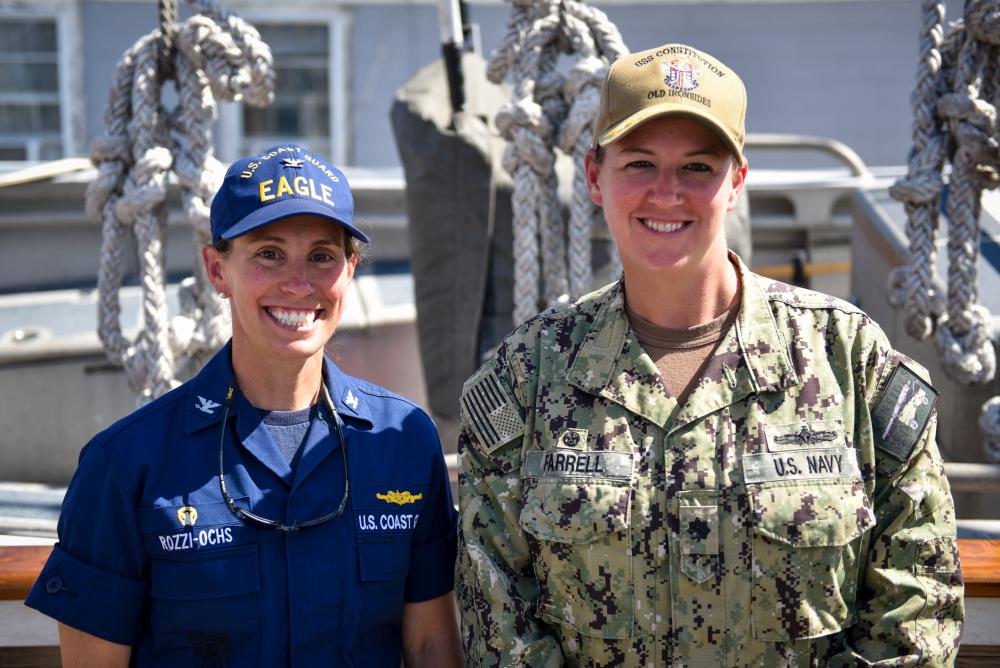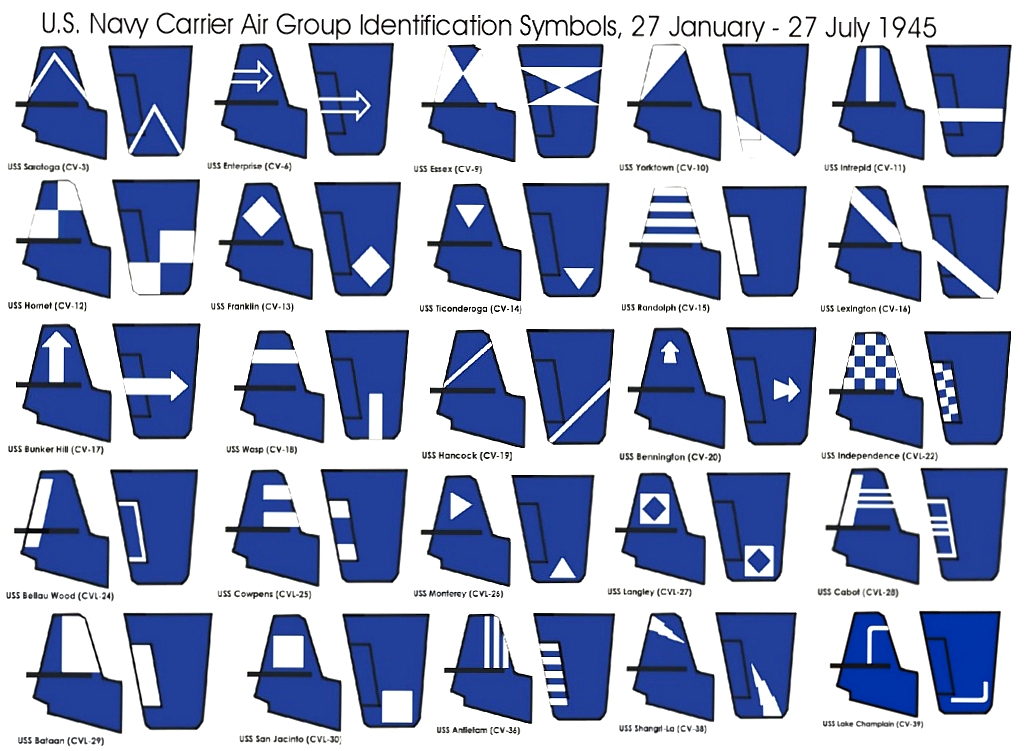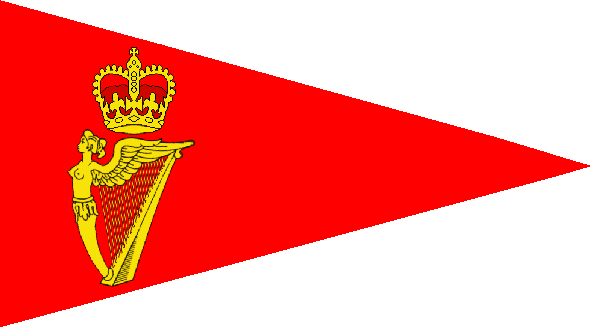|
Broad Pennant
A broad pennant is a triangular swallow-tailed naval pennant flown from the masthead of a warship afloat or a naval headquarters ashore to indicate the presence of either: (a) a Royal Navy officer in the rank of Commodore, or (b) a U.S. Navy Captain serving in a designated Commodore command billet. The flag is so called as a broad pennant because its dimensions are roughly 2:3. Starting in 1826, a Royal Navy commodore would fly one of two broad pennants depending on whether he had a captain for his ship (First Class Commodore), or also had to command it himself (Second Class). This difference was shown by a ball added to the pennant of the Second Class rank holder, as shown above. In 1958, the rank of First Class Commodore was terminated, after which only the red and white broad pennant with a ball was used by the Royal Navy. The U.S. Navy will also refer to this flag as a Commodore's "command pennant." In the U.S. Navy, the blue and white pennant will contain either ... [...More Info...] [...Related Items...] OR: [Wikipedia] [Google] [Baidu] |
United States Navy
The United States Navy (USN) is the maritime service branch of the United States Armed Forces and one of the eight uniformed services of the United States. It is the largest and most powerful navy in the world, with the estimated tonnage of its active battle fleet alone exceeding the next 13 navies combined, including 11 allies or partner nations of the United States as of 2015. It has the highest combined battle fleet tonnage (4,635,628 tonnes as of 2019) and the world's largest aircraft carrier fleet, with eleven in service, two new carriers under construction, and five other carriers planned. With 336,978 personnel on active duty and 101,583 in the Ready Reserve, the United States Navy is the third largest of the United States military service branches in terms of personnel. It has 290 deployable combat vessels and more than 2,623 operational aircraft . The United States Navy traces its origins to the Continental Navy, which was established during the American Revo ... [...More Info...] [...Related Items...] OR: [Wikipedia] [Google] [Baidu] |
Pennon
A pennon, also known as a pennant or pendant, is a long narrow flag which is larger at the hoist than at the fly. It can have several shapes, such as triangular, tapering (square tail) or triangular swallowtail (forked tail), etc. In maritime use, pennants are to be hung from the main truck. Pennon-style flags were one of the principal three varieties of flags carried during the Middle Ages (the other two were the banner and the standard). The pennon is a flag resembling the guidon in shape, but only half the size. It does not contain any coat of arms, but only crests, mottos and heraldic and ornamental devices. Pennoncell, streamer and wimpel are minor varieties of this style of flag (see variant types). Etymology Pennon comes from the Latin ''penna'', meaning "a wing" or "a feather". Initially it was a term for a "small pennant". Pennant have been used as a general (and imprecise) term for flags which are not strictly rectangular. Pendant is an obsolete spelling of p ... [...More Info...] [...Related Items...] OR: [Wikipedia] [Google] [Baidu] |
Mast (sailing)
The mast of a sailing vessel is a tall spar, or arrangement of spars, erected more or less vertically on the centre-line of a ship or boat. Its purposes include carrying sails, spars, and derricks, and giving necessary height to a navigation light, look-out position, signal yard, control position, radio aerial or signal lamp. Large ships have several masts, with the size and configuration depending on the style of ship. Nearly all sailing masts are guyed. Until the mid-19th century, all vessels' masts were made of wood formed from a single or several pieces of timber which typically consisted of the trunk of a conifer tree. From the 16th century, vessels were often built of a size requiring masts taller and thicker than could be made from single tree trunks. On these larger vessels, to achieve the required height, the masts were built from up to four sections (also called masts). From lowest to highest, these were called: lower, top, topgallant, and royal masts. Giving the ... [...More Info...] [...Related Items...] OR: [Wikipedia] [Google] [Baidu] |
Commodore (rank)
Commodore is a senior naval rank used in many navies which is equivalent to brigadier and air commodore. It is superior to a navy captain, but below a rear admiral. It is either regarded as the most junior of the flag officers rank or may not hold the jurisdiction of a flag officer at all depending on the officer's appointment. Non-English-speaking nations commonly use the rank of flotilla admiral, counter admiral, or senior captain as an equivalent, although counter admiral may also correspond to ''rear admiral lower half'' abbreviated as RDML. Traditionally, "commodore" is the title for any officer assigned to command more than one ship, even temporarily, much as "captain" is the traditional title for the commanding officer of a single ship even if the officer's official title in the service is a lower rank. As an official rank, a commodore typically commands a flotilla or squadron of ships as part of a larger task force or naval fleet commanded by an admiral. A commodo ... [...More Info...] [...Related Items...] OR: [Wikipedia] [Google] [Baidu] |
Captain (United States O-6)
In the United States Navy, United States Coast Guard, United States Public Health Service Commissioned Corps (USPHS), and National Oceanic and Atmospheric Administration Commissioned Officer Corps (NOAA Corps), captain is the senior-most commissioned officer rank below that of flag officer (i.e., admirals). The equivalent rank is colonel in the United States Army, Air Force, Space Force, and Marine Corps. Reflecting its nautical heritage, the term ''captain'' is used as a military title by more junior officers who command a commissioned vessel of the Navy, Coast Guard, or National Oceanic and Atmospheric Administration (NOAA) ship of patrol boat size or greater. Officers below O-6 who command aviation squadrons (typically O-5 commanders) usually use the less formal title "skipper". Insignia File:US-O6 insignia.svg, USN, USCG, USPHSCC, and NOAACOC collar, cover (hat), or shoulder rank insignia (on select uniforms) File:US Navy O6 insignia.svg, The eagle, shoulder boards, an ... [...More Info...] [...Related Items...] OR: [Wikipedia] [Google] [Baidu] |
Commodore (United States)
Commodore was an early title and later a rank in the United States Navy, United States Coast Guard and the Confederate States Navy, and also has been a rank in the United States Public Health Service Commissioned Corps and the National Oceanic and Atmospheric Administration Commissioned Officer Corps (NOAA Corps) and its ancestor organizations. For over two centuries, the designation has been given varying levels of authority and formality. Today, it is no longer a specific rank within active-duty or reserve forces or in the Public Health Service Commissioned Corps or NOAA Corps, but it remains in use as an ''honorary title'' within the U.S. Navy and U.S. Coast Guard for those senior captains (pay grade O-6) in command of operational organizations composed of multiple independent subordinate naval units (e.g., multiple independent ships or aviation squadrons). However, "commodore" is a rank that is actively used to this day in the United States Coast Guard Auxiliary, the civ ... [...More Info...] [...Related Items...] OR: [Wikipedia] [Google] [Baidu] |
Royal Navy
The Royal Navy (RN) is the United Kingdom's naval warfare force. Although warships were used by English and Scottish kings from the early medieval period, the first major maritime engagements were fought in the Hundred Years' War against France. The modern Royal Navy traces its origins to the early 16th century; the oldest of the UK's armed services, it is consequently known as the Senior Service. From the middle decades of the 17th century, and through the 18th century, the Royal Navy vied with the Dutch Navy and later with the French Navy for maritime supremacy. From the mid 18th century, it was the world's most powerful navy until the Second World War. The Royal Navy played a key part in establishing and defending the British Empire, and four Imperial fortress colonies and a string of imperial bases and coaling stations secured the Royal Navy's ability to assert naval superiority globally. Owing to this historical prominence, it is common, even among non-Britons, to ref ... [...More Info...] [...Related Items...] OR: [Wikipedia] [Google] [Baidu] |
Strike Fighter Wing Atlantic
{{Infobox military unit , unit_name = Strike Fighter Wing Atlantic , native_name = , image =File:Strike Fighter Wing Atlantic.jpg , image_size =300 , alt = , caption = , dates = 1 September 1993-Present , disbanded = , country ={{flag, United States of America , countries = , allegiance = , branch ={{nowrap, United States Navy , type = Fighter/Attack , role = Type Wing , size = , command_structure = {{nowrap, Naval Air Force Atlantic , garrison ={{nowrap, NAS Oceana , garrison_label = , nickname = , patron = , motto = , colors = , colors_label = , march = , mascot = , anniversaries = , equipment = , equipment_label = , battles = , decorations = , battle_honours = , battle_honours_label = , flying_hours = , website = , current_commander = , commander1 = CAPT Kevin McLaughlin, USN , commander1_label = Commodore , commander2 = CAPT Brian Becker, USN , commander2_label = Dep. Commodore , commander3 = CMDCM Anthony R. Sanders, USN , commande ... [...More Info...] [...Related Items...] OR: [Wikipedia] [Google] [Baidu] |
Naval Aviation
Naval aviation is the application of military air power by navies, whether from warships that embark aircraft, or land bases. Naval aviation is typically projected to a position nearer the target by way of an aircraft carrier. Carrier-based aircraft must be sturdy enough to withstand demanding carrier operations. They must be able to launch in a short distance and be sturdy and flexible enough to come to a sudden stop on a pitching flight deck; they typically have robust folding mechanisms that allow higher numbers of them to be stored in below-decks hangars and small spaces on flight decks. These aircraft are designed for many purposes, including air-to-air combat, surface attack, submarine attack, search and rescue, matériel transport, weather observation, reconnaissance and wide area command and control duties. Naval helicopters can be used for many of the same missions as fixed-wing aircraft while operating from aircraft carriers, helicopter carriers, destroyers and f ... [...More Info...] [...Related Items...] OR: [Wikipedia] [Google] [Baidu] |
Carrier Air Wing
A carrier air wing (abbreviated CVW) is an operational naval aviation organization composed of several aircraft squadron (aviation), squadrons and detachments of various types of fixed-wing aircraft, fixed-wing and rotorcraft, rotary-wing aircraft. Organized, equipped and trained to conduct modern US Navy carrier air operations while embarked aboard aircraft carriers, the various squadrons in an air wing have different but complementary (and sometimes overlapping) missions, and provide most of the striking power and electronic warfare capabilities of a carrier battle group (CVBG). While the CVBG term is still used by other nations, the CVBG in US parlance is now known as a carrier strike group (CSG). Until 1963, Carrier Air Wings were known as Carrier Air Groups (CVGs). Carrier Air Wings are what the United States Air Force would call "composite" wings, and should not be confused with U.S. Navy List of United States Navy aircraft wings, ''Type'' Wings (such as Strike Fighter W ... [...More Info...] [...Related Items...] OR: [Wikipedia] [Google] [Baidu] |
Burgee
A burgee is a distinguishing flag, regardless of its shape, of a recreational boating organization. In most cases, they have the shape of a pennon, pennant. Etiquette Yacht clubs and their members may fly their club's burgee while under way and at anchor, day or night. Sailing vessels may fly the burgee either from the main masthead or from a halyard under the lowermost starboard spreader. Most powerboats (i.e. those lacking any mast or having a single mast) fly the burgee off a short staff at the bow; two-masted power vessels fly the burgee at the foremast. Flag officers The Yacht club#Organization, officers of a yacht club may fly various burgees appropriate to their rank: for example, the commodore may fly a swallow-tailed version of the club burgee (and the vice- and rear-commodores the same, but distinguished by the addition of one or two balls respectively at the Canton (flag), canton). A past-commodore may also be given a distinctively-shaped flag.'Flags and Signals' ... [...More Info...] [...Related Items...] OR: [Wikipedia] [Google] [Baidu] |

.jpg)




